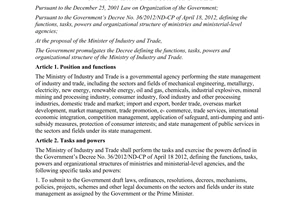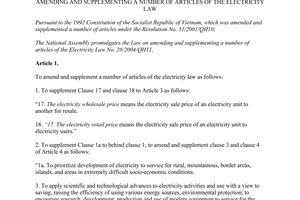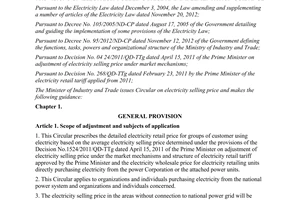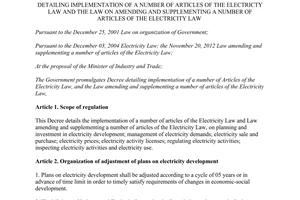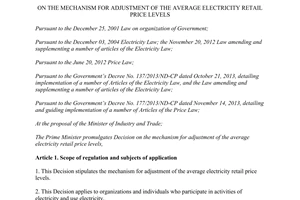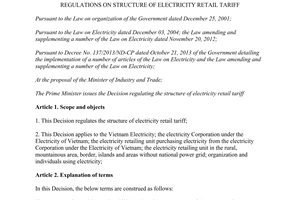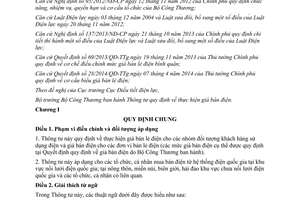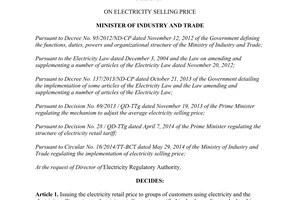Nội dung toàn văn Circular No. 16/2014/TT-BCT regulations on electricity price
|
THE MINISTRY
OF INDUSTRY AND TRADE |
SOCIALIST
REPUBLIC OF VIETNAM |
|
No.: 16/2014/TT-BCT |
Hanoi, May 29, 2014 |
CIRCULAR
REGULATIONS ON ELECTRICITY PRICE
Pursuant to the Government’s Decree No. 95/2012/NĐ-CP dated November 12 defining the functions, tasks, entitlements and organizational structure of The Ministry of Industry and Trade
Pursuant to Law on Electricity dated December 03, 2004 and the Law on amendments and supplements to Law on Electricity dated November 20, 2012;
Pursuant to the Government’s Decree No. 137/2013/NĐ-CP dated October 21, 2013 detailing the implementation of a number of articles of Law on Electricity and the law amending and supplementing a number of articles of the Law on Electricity;
Pursuant to the Prime Minister’s Decision No.69/2013/QĐ-TTg dated November 19, 2013 regulating average retail price of electricity;
Pursuant to the Prime Minister’s Decision No. 28/2014/QĐ-TTg dated April 07, 2014 regulating framework of retail price of electricity;
At the proposal of General Director of Electricity Regulatory Authority
The Minister of Industry and Trade promulgates the Circular regulating price of electricity.
Chapter I
GENERAL PROVISIONS
Article 1. Scope and regulated entities
1. This Circular regulates retail price of electricity (hereinafter referred to as retail price) for electricity users and retailers (specific retail price is stipulated in the Decision on electricity price promulgated by the Ministry of Industry and Trade).
2. This Circular applies to organizations and individuals that purchase and sell electricity from the national electricity system; in rural, mountainous, borderline, island areas where connection with national grid is not yet established, and other relevant organizations, individuals.
Article 2. Interpretation of terms
In this Circular, some terms are construed as follows:
1. Wholesale price of electricity means the price of electricity applied to electricity retailers by Power Corporations, power companies or any organization affiliated to Vietnam Electricity
2. Limit of domestic electricity use means limit of used electricity by level as stipulated in Section 4.1 in the Appendix enclosed together with the Prime Minister's Decision No. 28/2014/QĐ-TTg dated April 07, 2014 on structure of electricity price (hereinafter referred to as the limit of electricity).
Article 3. Application of electricity price
1. Electricity price shall be applied to right subjects with power using purposes (hereinafter referred to as the using purposes) as regulated in this Circular.
Buyers (those who purchase electricity) shall declare their using purpose for the application of electricity price under this Circular.
In case there is some change to the using purposes that results in change to the electricity price, buyers must make a written notice to the seller (One who generates electricity for the purpose) 15 days in advance for adjustment to the contract in accordance with the using purpose. The seller must carry out the examination to apply the price appropriately. In case the application of electricity price deviating the using purpose has caused some loss to both buyer and seller, recovery of arrears or refund of electric bills must be made. In case the point of time when the application of wrong price starts is not determined, a period of 12 months (from the point of detection of wrong application and earlier) shall be applied for the calculation of recovery of arrears and refund of electric bills.
2. In case the buyer uses electricity for multiple purposes:
a) As for customers who register one electric meter for domestic purpose but use part of the amount of electricity from such meter for other purposes (production, business and services…), retail price for domestic purpose shall be applied for all the amount of electric energy measured by such meter;
b) As for customers who register one electric meter for purposes other than domestic purpose (hereinafter referred to as non-domestic purposes), the two sides shall negotiate the proportion of electricity used for each using purpose in reliance on real-life usage.
3. On the date when electricity price is changed according to the Decision promulgated by the Ministry of Industry and Trade, the seller must finalize readings from all electric meters except domestic one.
Finalization of electric meter readings from all electric meters must be confirmed by customers, third party or agreed by the two sides.
Article 4. Voltage-level based electricity price
1. Voltage-level based electricity price shall be applied to the following customers:
Customers who use electricity for production, business, services and public services;
b) Electric retailers (or retailers) in industrial parks
2. Electricity price shall be based on voltage level of each electric measurement systems.
Article 5. “Time of day” based electricity price
1. Time of day in this context is defined as follows:
Normal time: From Mondays to Saturdays+ From 04:00 to 09:30 (Five hours and 30 minutes);
+ From 11:30 to 17:00 (Five hours and 30 minutes);
+ From 20:00 to 22:00 (two hours)
- Sunday
From 04:00 to 22:00 (18 hours).
b) Peak time: from Mondays to Saturdays
+ From 09:30 to 11:30 (two hours);
+ From 17:00 to 20:00 (three hours).
- Sunday: No peak time
c) Low time
All days of week: from 22:00 to 04:00 the following morning (six hours).
2. “Time of day” based electricity price (hereinafter referred to as the three-rate manner) shall be applied to the following subjects:
Buyers who use electricity for production, business and services supplied via 25kVA+ transformer or pledge to use at least 2,000 kWh per month on average in three consecutive months;
b) Retailers in industrial parks;
c) Retailers for non-domestic purposes in commercial, service and domestic complexes;
Buyers are encouraged to use electricity under the three-rate meter (hereinafter referred to as three-rate meter buyers) for production, business and services with a transformer and an amount of electricity consumed below the limit as defined in Point a of this Clause. The seller shall be responsible for creating favorable conditions and providing guidance to such buyers on the installation of a three-rate meter.
3. The seller must ensure adequate provision of electric meters to three-rate meter buyers. During the period when a three-rate meter is not yet installed due to some difficulty faced by the seller, electricity price shall be based on the normal time frame.
4. In case the seller has adequate conditions for the installation of three-rate meters and has issued a written notice about the schedule of installation to three-rate meter buyers, such buyers must cooperate with the seller in the installation of a three-rate meter as soon as possible.
In case three-rate meter buyers refuse the installation of a three-rate meter after two times of notice issued by the seller (the minimum interval between the two notices is 10 days), after 15 days since the final notice is issued, the seller shall impose the price of peak time frame for all the consumed amount consumed on such buyers until a three-rate meter is installed.
5. In case a three-rate meter buyer shares an electric meter with other organizations and individuals that do not pledge to use a three-rate meter, such buyer must cooperate with the seller in installing a separate meter for these organizations and individuals with a price appropriately imposed.
6. In case a buyer who uses electricity for production, business and services is not a three-rate meter buyer as defined in Clause 2 of this Article, normal-time based price shall be applied.
Article 6. Conditions for application of wholesale price
1. Retailers in rural, collective, residential areas, commercial, service and domestic complexes and industrial parks must meet the following conditions:
Have a licence to distribute and sell electricity granted by the competent agency except the cases of exemption as defined in Point c, Clause 1, Article 34 of the Law on Electricity;
b) Have an account book as regulated in which entries of electricity retail business must be separated from other businesses;
c) Have a power purchase agreement (PPA) and electric meters installed to individual households as stipulated in Article 24 of the Law on Electricity and Clause 10 of Article 11 of the Law on Amendments and Supplements to a number of articles to the Law on Electricity;
d) Have invoices to be issued to customers under the PPA as stipulated by the Ministry of Finance.
2. If any retailer who fails to meet the conditions as defined in Clause 1 of this Article, Vietnam Electricity or its affiliates shall be responsible for making report to the Services of Industry and Trade who then makes submission to the People’s Committee of provincial level for consideration and decision on handing over the electricity network within the management of this retailer to Vietnam Electricity or its affiliates for retailing electricity to customers.
Chapter II
RETAIL PRICE
Article 7. Retail price for production
Retail price for production shall be applied to buyers who use electricity for production in the following industries:
1. Industry
2. Construction; transport; mining; forestry; aquatic and seafood production
3. Agriculture: cultivation, irrigation, cattle-breeding, aquatic and seafood production, preservative and anti-epidemic drug production.
4. Production of clean water for domestic, production and business purposes.
5. Production management offices situated in the area shared with the production area.
6. Stores for commodities (raw materials, finished products, semi-finished products) that are in production process and locations are in proximity to production area.
7. Enterprises producing and supplying public products and services except public lighting activities.
8. Drainage pumping, waterlogging fighting pump in cities, communes; wastewater treatment station.
9. Operators, transmission network, receiver & transmitter stations that belong to telecommunication companies or broadcasting companies.
10. Facilities in textile, breeding, poultry egg hatching, husking, ice production, welding, sawing, woodwork, rice drying, and agricultural product preservation.
11. Printing activities related to processing and manufacturing industries; printing activities of media agencies and publishing houses.
12. Industrial sewing, embroidering, laundry, food processing, agricultural, forestry and sea food production.
13. Mechanical product manufacturing; gold, silver, and gemstones production; software, negative proof and packages production.
14. Sterilization irradiation
15. Other production activities
Article 8. Retail price of electricity for business
Retail price is applied to buyers who use electricity for business and service purposes including:
1. Shops, service establishments, supermarkets, trade fairs, wholesale & retail trade establishments.
2. Currency and stock trading establishments, commercial banks, saving funds, financial and securities companies
3. Business operation establishments of media, telecommunication and broadcasting companies; communications and postal services providers (except universal and compulsory postal services).
4. Lottery companies
5. Insurance organizations (except social and medical insurance)
6. Tourist facilities, photography shops, dance halls, massage parlors and karaoke bars
7. Food and beverage shops, beauty salons, laundry, clothing and bike repair services.
8. Advertising activities of production, business and service establishments.
9. Motor vehicle, transport vehicles, consumer products and household appliances repair and renovation facilities.
10. Hotels, guest-houses by organizations and individuals; houses for hire for non-domestic purposes with electricity purchase agreements signed by owners;
11. Booking offices, commodity delivery station, lounges (including halls) in airports, train stations, bus stops and wharves.
12. Tollbooths, vehicle parking zones.
13. Commodity storage areas during circulation.
14. Offices, head offices of economic groups, corporations and companies except electricity users as defined in Clause 5, Article 7 hereof.
15. Representative offices of business organizations, customer service centers; consulting companies and notary offices;
16. Business departments of organizations that operate in such areas as culture, art, sports, houses of culture and information, sports stadiums, museums and exhibition hall;
17. Sports business establishments
18. Theaters, performance organizer companies; movies companies and cinemas; circuses;
Article 9. Retail price of electricity for administrative and non-profit establishments
1. Retail price is applied to hospitals, kindergartens, nursery schools, schools including:
a) Kindergartens, nursery schools, general schools of all levels, continuing education centers (general education only) and ethnic minority boarding-schools;
b) Hospitals (including funeral parlors and medical waste incinerators within hospital premises); medical facilities (including amount of electricity used for medical examination and treatment provided by preventive medical centers); treatment and rehabilitation facilities, professional disease treatment facilities; retirement homes, orphanages; drug rehabs, social labor education centers; detoxification, HIV/AIDS control and family planning counseling offices.
2. Retail price for public lighting, administrative and non-profit organizations shall be applied to the following subjects:
a) Public lighting at city streets, parks, hamlet gates; temples, pagodas, churches; ranked historical remains; martyrs’ cemetery; collective quarters or stairs of tenements;
b) Electricity used for lifts of multi-story apartment building; water pumps serving daily activities in collective quarters and residential blocks.
c) Electricity used for traffic lights;
d) Head offices of state administrative agencies; public service providers; armed forces unit; political, political and social organizations; professional associations;
dd) Head offices of embassies, diplomatic agencies, representative offices of international organizations (not intended for commercial purposes);
e) Head offices of media agencies, sport training centers: radio and television stations, houses of culture and information, sports stadiums; museums, memorial houses, exhibition houses, libraries, funeral parlors and crematorium;
g) Trade fairs, market management board, guest-houses that are supported in expenditure by the state budget. The buyers must provide legal documents concerning expenditure from the state budget as the basis for determination of pro rata price;
h) Healthcare insurance organizations, social insurance organizations;
i) Research agencies; universities, colleges, and vocational schools (public and private), other training establishments (except the cases as defined in Point a, Clause 1 of this Article);
k) Central and local publishing agencies, school and medical equipment suppliers, charity organizations;
l) Reserve warehouses defined as national reserve warehouses by competent authorities
m) Vietnam bank for social policies (not for profits);
n) Head offices of organizations in charge of management and operation of irrigation works;
o) Head offices of project management boards with respect to the projects using capital from the state budget;
3. In case administrative and non-profit agencies use electricity for goods production, or for business and services, the price of electricity shall be applied in proportion to the amount used for respective purposes;
Article 10. Retail price for domestic purpose
1. Retail price for domestic purpose is applied to households who use electricity for domestic purpose with a PPA signed with the seller. One limit of electricity is applied to each household using electricity in a month.
2. If a buyer is a group of separate households sharing the same meter, total amount of electricity to be billed to such buyer shall be determined by multiplying amount of electricity of each level by the number of households sharing the same meter.
3. Electricity used for domestic purpose by collective houses for officials, public servants, armed forces, houses for monks, nuns, priests; dormitories, price of electricity shall be applied as follows:
a) In case number of occupants is able to be declared (based on temporary residency register or the lists of officers, soldiers with confirmations from heads of the units with respect to the armed forces), every four occupants shall be considered as one household as the basis for application of retail price;
b) In case the number of occupants can not be declared, retail price (level 3) shall be applied: From 101-200 kWh for the entire amount of electricity measured at the meter.
4. Electricity used for domestic purposes by tenants, the price of electricity shall be applied as follows:
a) Every house for rent shall be made a PPA with the seller. House owners shall be responsible for presenting the tenant’s temporary residency register or any document confirming temporary residency of such tenant issued by police authorities in the administrative division;
b) In case tenant is a household: the house owner shall sign a PPA or authorize the household to sign the agreement (with payment commitment included), each household as tenant shall be applied with a limit of electricity;
c) In case tenants are students or employees (not a household):
- The seller shall apply a limit of electricity to the house owner based on temporary residency register or any document confirming temporary residency of such tenant issued by police authorities in the administrative division; Every four occupants shall be grouped as a household for application of domestic electricity price, specifically: one occupant is calculated as a forth of the limit, two occupants half of the limit, three occupants three-fourths of the limit and four occupants one limit;
- In case tenants are employees or students with validity period of temporary residency register being at least 12 months, the house owner or representative of the tenants (authorized by house owner) shall sign a power purchase agreement (enclosed with a payment commitment by the house owner). In case a renting period is less than 12 months, the house owner must sign a power purchase agreement;
- In case a tenant does not sign a power purchase agreement with the seller, the house owner shall charge the tenant for electric bills issued by the retailer plus 10% for the loss of electricity, expenses for lighting and pumping water for common use;
- When the number of occupants as tenants changes, the house owner shall make a written notice to the seller for making adjustment to the limit of electricity. The seller has the right to investigate and request the buyer to present temporary residency register on the monthly basis to determine the number of occupants for application of the limit of electricity;
- b) In case the number of occupants can not be declared, domestic electricity price (level 3) shall be applied: From 101-200 kWh for the entire amount of electricity measured at the meter.
5. Buyers who buy electricity via a transformer for domestic purpose, domestic electricity price shall be applied.
6. In case the seller is forced to shift the time for recording meter readings (due to some irresistible events), the amount of electricity of each level shall be adjusted according to the actual number of days of a recording period.
7. In case the day of meter readings recording does not coincide with the day of making adjustment to electricity price, the billing based on domestic electricity price shall be done by using interpolation methods as follows:
a) Actual amount of electricity used by customers during the meter readings recording;
b) Number of actual days of electricity use (the number of days between the two meter recordings, number of days for application of old price and new price)
c) Used amount of electricity of each level is calculated between the two meter readings recordings
8. Domestic electricity price (using prepaid card meter) shall be applied to temporary and short-term buyers for domestic purposes. When technical and legal conditions permit, the retailer shall be responsible for installing prepaid card meters in places where customers have demand for electricity for domestic purpose.
Article 11. Electricity price in industrial parks that buy electricity from the national grid and have a power plant constructed in-site
Retailers in the industrial parks with a power plant constructed in-site in combination with purchase of electricity from the national grid for re-sale to customers in the area shall be responsible for constructing an electricity price plan and making submission to the Services of Industry and Trade for appraisal, to Electricity Regulatory Authority for opinions and then to the People’s Committees of provinces for approval (on the annual basis).
Chapter III:
WHOLESALE PRICE
Article 12. Wholesale price in rural areas
1. Wholesale price in rural areas is applied to retailers in rural areas (except the cases as defined in Articles 13, 14, 15 of this Circular) for the amount of electricity measured at general electric meter installed in a transformer station regardless of whom the transformer station belongs to.
2. Wholesale price in rural areas
a) Wholesale price in rural areas is applied for amount of electricity used for domestic purpose by households that use the electricity in communes, hamlets, and villages purchased by retailers in rural areas from the general electric meter installed in a transformer station regardless of whom the transformer station belongs to or what voltage-level is;
b) Total amount of electricity with wholesale price for domestic purpose from the general electric meter shall be billed by amount of electricity of each level by the number of households behind such general electric meter;
c) Number of households that use electricity for domestic purpose behind the general electric meter is the number of households that have permanent residency register or long-term temporary residency register within scope of supply of the general electric meter and the limit of electricity specified in a power purchase agreement signed with retailers in rural areas;
Billing of wholesale price in rural areas in a month when changes to electricity price take place is done as follows: Amount of electricity of each level with old and new price being applied shall be determined by multiplying the amount of electricity of each level in a day by the actual number of days before and after price adjustment in that month. Amount of electricity of each level in a day is equal to the amount of electricity of each level divided by (:) actual number of days in the month of billing.
3. Wholesale price for purposes other than the abovementioned purposes shall be applied for amount of electricity used for non-domestic purposes;
4. Amount of electricity with the wholesale price for non-domestic purposes shall be determined by multiplying the total amount of commercial electricity used for other purposes measured at retail meters by coefficient 1.1.
5. Amount of electricity with wholesale price for domestic purpose in rural areas shall be determined by subtracting the amount of electricity used for other purposes from the total amount of electricity measured at the general electric meter.
6. Within three days since the recording of general electric meter readings starts, the retailer in rural areas must provide the followings to the wholesaler:
a) Enumeration of amount of commercial electricity used for other purposes;
b) Number of households using electricity after the general electric meter for domestic purpose with confirmations from legal representative of the retailer;
c) List of increase or decrease (if any) in the number of households confirmed by police authorities of communes;
After this time limit, if the retailer fails to provide documents as mentioned above, the wholesaler shall be permitted to impose level 4 of the wholesale price in rural areas (from 201-300kWh for the entire amount of electricity measured at general electric meter).
7. In case transformers in farms, plantations in rural areas supply electricity for domestic and other purposes, domestic electricity wholesale price shall be applied for the entire amount of electricity measured at general electric meter.
Article 13. Wholesale price in collective quarters and residential areas
1. Wholesale price in collective quarters and residential areas shall be applied to the following subjects:
a) Retailers in the collective quarters of agencies, companies, factories, construction sites, farms and plantations (regardless of whether geographical position of the collective quarter is in rural or urban area);
b) Retailers in rural areas that purchase electricity via the general electric meter installed at the shunt of a low-voltage line;
c) Retailers in residential areas in cities, towns, communes.
2. Wholesale price in collective quarters and residential areas
a) Total amount of electricity with wholesale price for domestic purpose at general electric meter shall be determined by multiplying the amount of electricity of each level by the number of households behind such general electric meter;
b) Number of households that use domestic electricity in collective quarters, residential areas behind the general electric meter is the number of households that have permanent residency registers or long-term temporary residency registers within scope of supply of the general electric meter and the limit of electricity specified in a power purchase agreement signed with retailers in collective quarters, residential areas;
Billing of wholesale electricity price in collective quarters and residential areas in a month when changes to electricity price take place is done as follows: Amount of electricity of each level with old and new price being applied shall be determined by multiplying amount of electricity in a day by the actual number of days before and after price adjustment in that month. Amount of electricity of each level in a day is determined by dividing the amount of electricity of each level by the actual number of days in the month of billing.
3. Wholesale price of electricity (behind general electric meter) for other purposes in collective quarters, residential areas shall be applied according to electricity price for non-domestic purposes;
4. Amount of electricity with wholesale price for non-domestic purposes applied shall be billed by multiplying total amount of commercial electricity used for other purposes measured at retail meters by coefficient 1.1.
5. Amount of electricity with wholesale price for domestic purpose applied in collective quarters, residential areas shall be billed by subtracting the total amount of electricity measured at general electric meter from the total amount of electricity with wholesale price for non-domestic purposes.
6. Within three days since the recording of general electric meter readings starts, the retailer in collective quarters and residential areas must provide the followings to the wholesaler:
a) Enumeration of amount of commercial electricity used for other purposes;
b) Number of households using electricity after general electric meter for domestic purpose with confirmations from legal representative of electricity retailer;
c) List of increase or decrease (if any) in the number of households confirmed by police authorities of communes;
After this period, if the retailer fails to provide adequate documents mentioned above, the wholesaler is permitted to impose level 4 of the wholesale price applied in collective quarters, residential areas (from 201-300kWh for the entire amount of electricity measured at the general electric meter).
7. For the administrative divisions that are converted from rural division into town, commune, or city divisions, or from town into commune and city divisions according to the competent authorities’ decision, retailers in aforesaid divisions are permitted to temporarily retain the price applied to old divisions within less than 12 months since the decision to adjust division is issued. After this period, retailers must apply the price applied to new divisions.
Article 14. Wholesale price in commercial, service and domestic complexes
1. Wholesale price in commercial, service and domestic complexes shall be applied to retailers in apartment buildings, urban zones, shopping mall; office buildings for rent (regardless of whether geographical positions of the commercial, service and domestic complexes are in rural or urban areas).
2. Wholesale price in commercial, service and domestic complexes
a) Wholesale price of electricity in commercial, service and domestic complexes shall be applied with respect to the amount of electricity used for domestic purpose by households purchased by retailers from the general electric meter installed in a transformer station regardless of what voltage-level is;
b) Total amount of electricity at the general electric meter shall be billed by multiplying the amount of each level by the number of households using electricity for domestic purpose after such general electric meter;
c) Number of households that use electricity for domestic purpose behind the general electric meter in commercial, service, and domestic complexes is the number of households that have permanent residency registers or long-term temporary residency registers within scope of supply of the general electric meter and the limit of electricity specified in a power purchase agreement signed with retailers in rural areas;
d) Billing of amount of electricity based on the wholesale price in commercial, service and domestic complexes in a month when changes to electricity price take place is done as follows: The amount of electricity of each level with old and new price applied shall be billed by multiplying amount of electricity in a day by the actual number of days before and after price adjustment in that month. Amount of electricity of each level in a day is determined by dividing the amount of electricity of each level by the actual number of days in the month of billing.
3. Wholesale price for other purposes in commercial, service and domestic complexes shall be applied according to the three-rate meter (as defined in Article 5 hereof) with respect to the amount of electricity used for non-domestic purpose regardless of what voltage-level is.
4. Billing of amount of electricity from the general electric meter shall be done as follows:
a) Both the seller and buyer in reliance on real-life usage shall carry out negotiations on application of prices for domestic or non-domestic purposes as the basis for application of price at the general electric meter;
b) In case the commercial, service and domestic complexes have their own meter for domestic and non-domestic electricity behind the general electric meter, the billing of amount of electricity used for domestic and non-domestic purposes shall be based on their own meter installed behind the general electric meter;
a) In case the commercial, service and domestic complexes do not use electricity for domestic purpose, the wholesale price for other purposes shall be applied for the entire amount of electricity measured from the general electric meter;
5. Within three days since the recording of general electric meter readings, retailers must provide the followings to the wholesaler:
a) Enumeration of amount of commercial electricity used for other purposes;
b) Number of households using electricity behind the general electric meter for domestic purpose with confirmations from legal representative of electricity retailer;
c) List of increase or decrease (if any) in the number of households confirmed by police authorities of communes;
After this period, if the retailer fails to provide the documents mentioned above, the wholesaler is permitted to impose the wholesale price for other purposes on the entire amount of electricity measured from the general electric meter).
Article 15. Wholesale price in industrial parks
1. The wholesale price at 110kV busbar of the 110kV transformer in the industrial park shall be applied to retailers who purchase electricity from the 110kV busbar (110kV transformer invested by the buyer) of the industrial park for resale to customers using electricity in the industrial park. The wholesale price applied to each 110kV transformer shall be determined by referring to total capacity of the 110kV transformer installed in the industrial park.
2. The wholesale price at medium-voltage busbar of the 110kV transformer or at the shunt of a medium-voltage line leading to the industrial park shall be applied to retailers who purchase electricity for resale to customers using electricity in the industrial park at medium-voltage level.
3. The wholesale price applied to retailers at medium-voltage level of the low-voltage transformers shall be equal to the retail price applied to production industries at corresponding medium-voltage level.
Chapter IV:
IMPLEMENTATION
Article 16. Implementation
1. Electricity Regulatory Authority shall be responsible for making submission to the Ministry of Industry and Trade for issuing decision on electricity price applied to customers and to retailers in reliance on the Prime Minister’s Decision No. 28/2014/QĐ-TTg dated April 07, 2014 on structure of retail price of electricity.
2. the Service of Industry and Trade shall:
a) Inspect and oversee the compliance with electricity price as defined hereof by retailers within the management division. Upon detecting that retailers fail to meet the conditions as defined in Article 6 hereof, the Services of Industry and Trade shall make report to People’s Committee of provincial level for decision on handing over the electric grid under the management of this retailer to Power Corporations or its affiliates for retailing electricity to customers.
b) Inspect and oversee the billing of limit of electricity on households and the application of retail price to houses for hire to ensure right price is applied to tenants as defined hereof.
Article 17. Effect
1. This Circular takes effect since June 01, 2014 and replaces the Ministry of Industry and Trade’s Circular No.19/2013/TT-BCT dated July 31, 2013 on regulations and guidance on electricity price.
2. Difficulties that arise during the implementation of this Circular should be reported to Electricity Regulatory Authority or the Ministry of Industry and Trade for consideration and handling./.
|
|
PP THE
MINISTER |
------------------------------------------------------------------------------------------------------
This translation is made by LawSoft and
for reference purposes only. Its copyright is owned by LawSoft
and protected under Clause 2, Article 14 of the Law on Intellectual Property.Your comments are always welcomed

